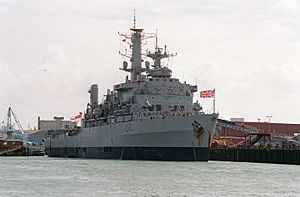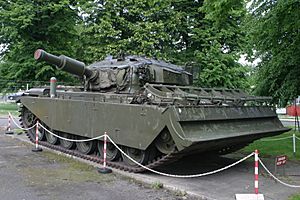Operation Motorman facts for kids
Quick facts for kids Operation Motorman |
|
|---|---|
| Part of the Troubles and Operation Banner | |
| Location |
|
| Planned by | Major-General Robert Ford |
| Objective | Retake republican-controlled areas |
| Date | 04:00, 31 July 1972 (+01:00) |
| Executed by |
|
| Outcome | British victory
|
| Casualties |
|
Operation Motorman was a very large military action by the British Army in Northern Ireland. It happened during a time of conflict known as the Troubles. The operation took place early on July 31, 1972. Its main goal was to take back control of "no-go areas." These were parts of cities like Belfast and Derry that local residents and armed groups controlled. In Derry, this part of the operation was also called Operation Carcan.
Contents
Understanding the Background
The riots in Northern Ireland in August 1969 started a period of conflict called the Troubles. After these riots, cities like Belfast and Derry became more divided. Many neighborhoods became mostly Irish nationalist or mostly unionist.
What Were "No-Go Areas"?
In some places, people and armed groups built barricades. These barriers were meant to protect their neighborhoods from the "other side" or from security forces. These areas became known as "no-go areas" because it was hard for the police or army to enter them.
By late 1971, there were 29 barricades blocking access to an area known as Free Derry. Many of these "no-go areas" were controlled by groups like the Provisional IRA or the Official IRA.
Why Did Operation Motorman Happen?
On July 21, 1972, the Provisional IRA set off 22 bombs in Belfast within 75 minutes. This attack, known as Bloody Friday, killed nine people and injured 130. This event made the British Government decide to launch Operation Motorman just ten days later.
Getting Ready for the Operation
Operation Motorman was the largest British military operation since 1956. To prepare, about 4,000 extra soldiers were sent to Northern Ireland. Nearly 22,000 soldiers took part in total. They were supported by 5,300 soldiers from the local Ulster Defence Regiment (UDR).
Special vehicles called Centurion AVREs were used. These were like tanks with bulldozer blades. They were the only heavy armored vehicles the British Army used in Northern Ireland during the Troubles. These tanks arrived on a ship called HMS Fearless.
The large number of soldiers and vehicles made the IRA aware that a major operation was coming. Reports suggest that the IRA members left Derry's "no-go areas" the day before the operation began.
How the Operation Unfolded
The operation started around 4:00 a.m. on July 31 and lasted for a few hours. In places like Free Derry, residents sounded sirens to warn others. The British Army used bulldozers and Centurion AVREs to break through the barricades. Then, many soldiers in smaller, lighter armored vehicles moved into the "no-go areas."
Neither the Provisional IRA nor the Official IRA tried to fight back. Smaller operations also took place in other towns like Lurgan, Armagh, Coalisland, and Newry. The Royal Air Force (RAF) used planes to search for hidden weapons.
By the end of the day, the "no-go areas" in Derry and Belfast were cleared. However, the Army remained careful when operating in areas with strong support for Irish republican groups.
People Affected by the Operation
During Operation Motorman, British soldiers shot four people in Derry. One civilian and one unarmed IRA member were killed.
- Daniel Hegarty: A 15-year-old boy, Daniel, was shot and killed along with his two cousins in Derry. They had gone out to see the tanks. Soldiers, hidden behind a fence, fired at them from close range. Daniel was shot twice in the head. His cousin, Christopher, was also hit but survived.
- Years later, an investigation found that the boys were not a threat when they were shot. The soldier involved, known as "Soldier B," was charged with murder in 2019. However, these charges were later dropped in 2021. In 2023, a court ruled that the charges should be brought back.
- Seamus Bradley: A 19-year-old member of the Provisional IRA, Seamus, was shot and killed by a British soldier. The army first said he was armed. But an investigation in 2019 found that he was unarmed and running when he was shot. The investigation also said he might have lived if he had received first aid quickly.
In Belfast, some people were arrested, but there was no armed fighting.
What Happened Next
A few hours after Operation Motorman ended, the IRA set off three car bombs in Claudy village. This event, known as the Claudy bombing, killed nine civilians.
In the years that followed, the Republic of Ireland continued to be a place where IRA members could find safety. They used the country to raise money, train new members, and cross the border to avoid British security forces.



